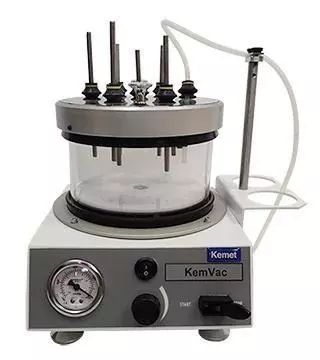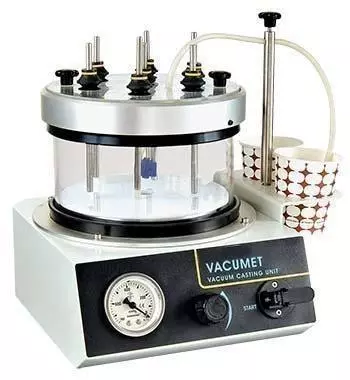Vacuum Impregnation System
This is mainly used for porous materials such as ceramics and sprayed coatings, thus reinforcing fragile materials. For this type of work, Epoxy resins are used, due to their low viscosity and low vapour pressure. When mixed with a fluorescent dye, they can be used for pore detection. Vacuum Impregnation is carried out by placing the mount into a bell jar, which is connected to a vacuum pump with tubing and connectors. The vacuum pulls any entrapped air from the Epoxy encapsulating the sample. The displaced air is replaced with Epoxy, providing complete bonding and support.
Vacuum Impregnation Unit (No Compressed air supply required)
The KemVac is designed for embedding and impregnation of porous materials. It removes the trapped air from the mounting material and eliminates the gaps between the specimen and the resin.
- No Compressed air supply required
- Has an integrated vacuum pump requiring only 230V AC
- Produces a vacuum to -0.65bar
- Self contained vacuum impregnation unit with gauge
- Incorporated vacuum pump and control circuit
- Compact and simple to use
- Efficient Impregnation
- Multi-specimen application
- Vacuum gauge
- Electricity: 220-1-50
- The KemVac is supplied with one set of supplies for casting epoxy resins.

Impregnation Unit for cold mounting
Most mineralogical specimen have porosites, cavities and cracks and therefore need to be embedded under vacuum. VACUMET fulfils this requirement easily and efficiently.
- Requires positive air pressure from a compressor
VACUMET is supplied with one set of supplies for casting epoxy resins. Optional Vacumet consumable kit (10 cups, 10 silicone tubes, resin & hardener) available.

Advantages of using a Vacuum Impregnation
Encapsulation and/or impregnation of a sample with a resin, especially if it is soft, powdery, cracked, brittle, friable, or broken is helpful to: (a) fill the voids, pores and cracks; (b) improve the overall integrity and ease of handling; (c) preserve the original microstructure and distribution of components and edges in the sample; (d) keep the detached, de-bonded, fragmented portions adhered to the rest of the sample; and (e) prepare a solid mass of the original fragmented or powdery sample for sectioning, grinding, thin-sectioning, or polishing. Encapsulation indicates immersion of the sample within a resin in a mold to improve the external integrity of brittle, friable materials and for better handling for subsequent sampling steps, whereas impregnation indicates injecting or penetrating a liquid resin into a porous sample to improve its internal as well as external integrity. Epoxy-based resins are best for both encapsulation and impregnation. The lower the viscosity of the epoxy, the deeper its depth of penetration into the sample during impregnation, and the better its mechanical bond to the constituents.
